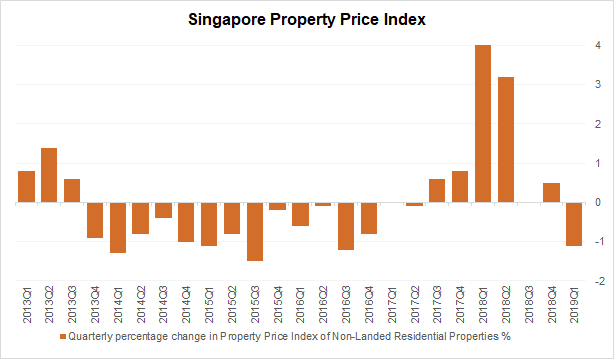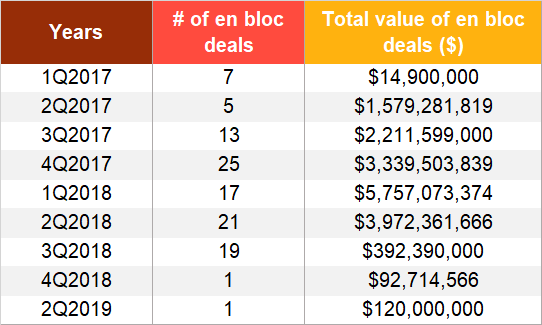Today marks exactly one year since the Government dropped the surprise announcement that it was raising Additional Buyer’s Stamp Duty (ABSD) rates and tightening Loan-To-Value (LTV) limits just after 7pm on July 5.
The measures, which took effect the next day, came as a surprise, arriving just as property developers replenished their land banks throughout 2017 and into 1H2018, in anticipation of blockbuster sales.
How have the cooling measures impacted the housing market since and which segments were hit the hardest? More importantly, what should buyers and investors keep a lookout for moving forward? Read on for answers.
- ABSD rates pre-and-post cooling measures
Source: IRAS
1) First things first, they DID curb soaring home prices
In the first place, the measures were introduced to cool an overheating residential property market.
The move came just days after official data showed that private home prices had risen to its highest point in four years in 2Q2018 (as shown in the chart below), with analysts predicting that prices could soon recover to 2013 peak levels.
- Singapore Property Price Index
Source: URA, PropertyGuru
The effects of the property curbs were immediately felt, turning the tide on soaring home prices over the next quarter following its implementation. Total sales volume also plunged by almost half over the next 12 months.
Despite that, home prices remained relatively stable, with the price index rising by just 0.5% over the last two quarters of 2018, and registered just a slight dip in the first quarter of the year. But in a surprising turn of events, home prices unexpectedly rose again in 2Q2019 (more on this under point no. 3).
But largely, it would appear that the property cooling measures have achieved just what they were put in place for, which was – as Mr Lawrence Wong, Minister for National Development (MND) puts it – to stabilise the property cycle.
Prices were rising very sharply and there was a very real risk that prices would outpace fundamentals, said Wong at a recent Bloomberg interview. “It (the cooling measures) was, as we had stressed then, not to bring down prices but to stabilise and moderate the cycle, and I think we have achieved that effect,” he said.
2) They also caused an overall slowdown in buying demand (but sparked some oversupply fears)
It goes without saying that a slowdown in buying demand was what led to a stabilisation in home prices in the first place. But what’s interesting here is that while resale transactions are observed to have plummeted over the past year, the volume of new sales transactions have remained relatively stable.
Based on caveats lodged, we saw a -57% reduction in resale volume from 3,951 units in 2Q2018 to 1,689 units in 2Q2019. New sales volume on the other hand, fell by just -3%, with 2,215 units in 2Q2018 to 2,147 units in 2Q2019.
What this suggests is that while buying demand has been dampened by the measures, they have not been completely quelled and there remains an appetite for new projects that are attractively priced for their tenure and locations (more on this in the next point).
- The resale market bore the brunt of the property cooling measures
Source: URA, PropertyGuru
However, while reduced buying demand is an intended effect of the cooling measures, the large overall dip in buying activity has sparked some oversupply concerns, which prompted the Government to act to reduce private housing supply under the GLS programme for 2H2019 by 15%.
In the mid to long term, the cutback is expected to even out the supply-demand equilibrium in the Singapore housing market.
Looking for a new home but not sure where to start? Check out our Area Insider Guides for insights!
3) But even with higher stamp duties, certain new projects continue to enjoy healthy demand (while hitting new price highs)
As mentioned above, after two consecutive quarters of decline, private home prices rose unexpectedly in 2Q2019, during which the URA flash estimate registered a positive change of 1.3%. This brought the year-to-date change for 2019 to +0.6%.
The uptick was led by a strong growth of 3% in the Rest of Central Region (RCR) and 1.5% in the Core Central Region (CCR) prices.
Desmond Sim, CBRE’s head of research for Southeast Asia, attributes the upswing to new launches that are achieving new benchmark pricing on the back of increased land costs. He noted that certain new launches sold well during the quarter, and these projects were “valued on their tenure, location and reputation of the developer.”
He cited examples such as the freehold Amber Park and Coastline Residences in the East Coast, whose units achieved high take-up rates and pricing points, and were likely the key drivers behind the 3% growth in RCR home prices.
Within the CCR, high-end projects such as Boulevard 88 enjoyed buoyant sales. Launched in March 2019, the ultra-luxury freehold project moved 34 units during 2Q2019 at a median price of $3,692 psf, compared to 25 units in 1Q2019 at a median price of $3,606 psf.
- Within the CCR, high-end projects such as Boulevard 88 enjoyed buoyant sales in 2Q2019.
Notably, a 5,673 sq ft penthouse at the development sold at $28 million or $4,936 psf in May – the highest in psf terms to be achieved at the development.
Meanwhile, the nearby 3 Cuscaden, launched in November 2018, sold 27 units in 2Q2019 at a median price of $3,601 psf, up from 12 units at $3,506 psf in 1Q2019.
In the grander scheme of things, CBRE’s Sim believes that the uptick of prices in the second quarter of the year is merely an ‘anomaly’ and that the property index should still remain relatively stable in the near term.
4) However, the measures killed the en bloc market, and are likely causing the current holdback in new launches
Finally, let’s take a look at the segment that was perhaps hit the hardest by the cooling measures.
Along with higher stamp duty rates for buyers, the 2018 cooling measures also introduced a new, non-remissible 5% ABSD for developers when they purchase residential development sites (including en bloc sites).
In addition, the remissible ABSD for residential developers has been raised to 25% from the previous 15%. If a developer fails to complete a project and sell all of its units within five years of acquiring the site, it will have to pay the 25% ABSD with interest.
It is for this reason that the booming collective sales cycle quickly came to an end post-cooling measures.
- The cooling measures spelled the death of the en bloc market
Source: URA, PropertyGuru
To give you an idea of just how hot the collective sales market was – at its peak, there was a total of 50 en bloc deals in the whole of 2017, and 38 en bloc deals in the first six months of 2018 alone (so imagine where the market would have headed if the property curbs were not enforced).
Post-cooling measures, en bloc deals were decimated to just one in 4Q2018, and just one in the year of 2019 to date.
In the meantime, the roll-out of new private homes for sale has also been slower than initially predicted, with property developers holding back on new launches.
For the whole of 2019, analysts were expecting to see about 40 to 60 new launches from the previous en bloc fever, which could bring about as many as 23,000 to 25,000 new private housing units to the market. The bulk of these new launches were expected to be launched during the first two quarters of the year, but so far, we are only seeing about half of those projects being launched.
According to Winston Lee, PropertyGuru’s Regional Head of Special Projects, developers are currently adopting a ‘wait-and-see’ approach. “Those who can wait, will wait until market sentiment improves before they launch their new projects.”
Meanwhile, CBRE’s Sim says that developers who are unfazed by the sell-by deadlines are unlikely to reduce prices of these new launches.
Home buyers looking for Singapore Properties may like to visit our Listings, Project Reviews and Guides.
What’s next?
In the near term, it is unlikely that the authorities will introduce more cooling measures, though it doesn’t look like they’ll relax existing ones either.
This comes especially after Ravi Menon, managing director of the Monetary Authority of Singapore (MAS) announced at an annual report media briefing that the measures were implemented only a year ago and it takes time to allow them to work their way. But price increase has dampened and the market is more sober, and there is a good balance holding up the market, he said.
Moving forward, he assured that the Government will continue to monitor the property market to ensure a healthy and sustainable market.
Fiona Ho, Digital Content Manager at PropertyGuru, wrote this story. To contact her about this or other stories, email fiona@propertyguru.com.sg








